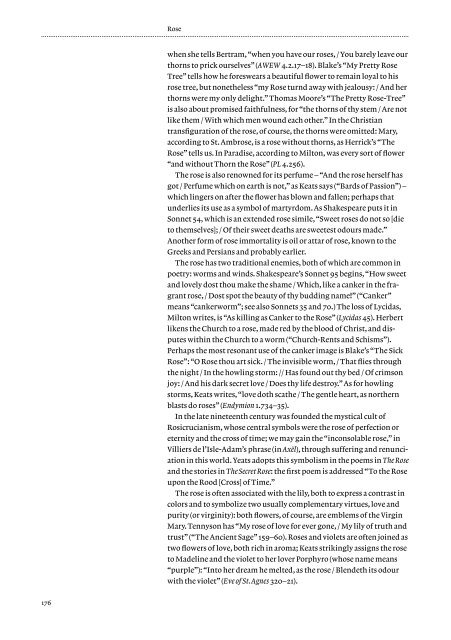book1_4209
book1_4209
book1_4209
Create successful ePaper yourself
Turn your PDF publications into a flip-book with our unique Google optimized e-Paper software.
Rosewhen she tells Bertram,“when you have our roses,/ You barely leave ourthorns to prick ourselves” (AWEW 4.2.17–18). Blake’s “My Pretty RoseTree” tells how he foreswears a beautiful flower to remain loyal to hisrose tree,but nonetheless “my Rose turnd away with jealousy: / And herthorns were my only delight.” Thomas Moore’s “The Pretty Rose-Tree”is also about promised faithfulness,for “the thorns of thy stem / Are notlike them / With which men wound each other.” In the Christiantransfiguration of the rose,of course,the thorns were omitted: Mary,according to St. Ambrose,is a rose without thorns,as Herrick’s “TheRose” tells us. In Paradise,according to Milton,was every sort of flower“and without Thorn the Rose” (PL 4.256).The rose is also renowned for its perfume – “And the rose herself hasgot / Perfume which on earth is not,” as Keats says (“Bards of Passion”) –which lingers on after the flower has blown and fallen; perhaps thatunderlies its use as a symbol of martyrdom. As Shakespeare puts it inSonnet 54,which is an extended rose simile,“Sweet roses do not so [dieto themselves]; / Of their sweet deaths are sweetest odours made.”Another form of rose immortality is oil or attar of rose,known to theGreeks and Persians and probably earlier.The rose has two traditional enemies,both of which are common inpoetry: worms and winds. Shakespeare’s Sonnet 95 begins,“How sweetand lovely dost thou make the shame / Which,like a canker in the fragrantrose,/ Dost spot the beauty of thy budding name!” (“Canker”means “cankerworm”; see also Sonnets 35 and 70.) The loss of Lycidas,Milton writes,is “As killing as Canker to the Rose” (Lycidas 45). Herbertlikens the Church to a rose,made red by the blood of Christ,and disputeswithin the Church to a worm (“Church-Rents and Schisms”).Perhaps the most resonant use of the canker image is Blake’s “The SickRose”: “O Rose thou art sick. / The invisible worm,/ That flies throughthe night / In the howling storm: // Has found out thy bed / Of crimsonjoy: / And his dark secret love / Does thy life destroy.” As for howlingstorms,Keats writes,“love doth scathe / The gentle heart,as northernblasts do roses” (Endymion 1.734–35).In the late nineteenth century was founded the mystical cult ofRosicrucianism,whose central symbols were the rose of perfection oreternity and the cross of time; we may gain the “inconsolable rose,” inVilliers de l’Isle-Adam’s phrase (in Axël),through suffering and renunciationin this world. Yeats adopts this symbolism in the poems in The Roseand the stories in The Secret Rose: the first poem is addressed “To the Roseupon the Rood [Cross] of Time.”The rose is often associated with the lily,both to express a contrast incolors and to symbolize two usually complementary virtues,love andpurity (or virginity): both flowers,of course,are emblems of the VirginMary. Tennyson has “My rose of love for ever gone,/ My lily of truth andtrust” (“The Ancient Sage” 159–60). Roses and violets are often joined astwo flowers of love,both rich in aroma; Keats strikingly assigns the roseto Madeline and the violet to her lover Porphyro (whose name means“purple”): “Into her dream he melted,as the rose / Blendeth its odourwith the violet” (Eve of St. Agnes 320–21).176


